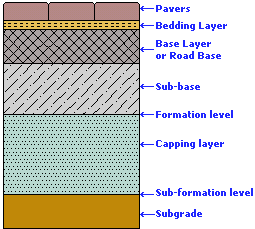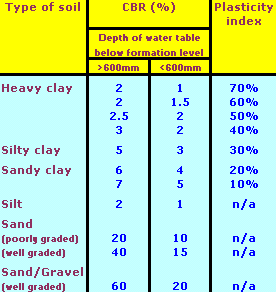Introduction:
In most circumstances, this procedure is not required for residential projects such as driveways or patios, unless there are special conditions, such as poor ground or exceptional loads.
The design process outlined on this page is given in full in British Standard BS 7533-1:2001- Guide for the structural design of heavy duty pavements constructed of clay or concrete pavers , which should be consulted for full details, This page describes the basic procedure used by engineers to specify a flexible pavement constructed from either clay bricks or concrete blocks.

Before any pavement construction can be specified, it is necessary to quantify the value of 2 variables....
- The CBR (California Bearing Ratio) of the sub-grade
- The expected traffic volumes and types over the design life of the pavement (usually 20 years)
Sub-grade CBR
See also sub-grades page
The CBR is usually quantified through onsite testing by qualified geo-technical engineers, but BS6677 gives a table of expected CBR's for typical British soils, which is reproduced opposite.
It should be noted that when considering a project of some size, such as a car park or public highway, a thorough site investigation is essential to map any variations in CBR over the site. As CBR is partly dependent on soil type and moisture content, testing should be done in inclement conditions that will give a more accurate indication of the lowest expected CBR. The pavement should be designed to cope with the lowest measured CBR.

If a site has a variable CBR, it may be possible to excavate 'soft spots' and replace with a suitable compacted fill material to bring up the CBR to an acceptable value, but this is a decision that can only be taken once all relevant data are collected and analysed, and often comes down to a judgement call made by the Resident Engineer based upon experience and local knowledge.
Any sub-grade with a CBR of 5% or less will require a capping layer, sometimes known as a sub-grade improvement layer. This is constructed from approved granular or cement-bound material, laid and compacted in layers not greater than 200mm thick. A sub-grade with a CBR of 2% or less should have a 600mm thick capping layer; a sub-grade with a CBR of 2-5% should have a capping layer 350mm thick.
To summarise this step in the design process........

Traffic volumes and types - Determining Sub-base
This next stage of the design process considers the usage of the pavement, and first specifies a thickness for the sub-base before determining whether a road base will be required.
To determine sub-base thickness, it is necessary to know if the pavement is to be used as an access road serving dwellings and/or commercial/industrial properties. If it is not to be used as an access road, then a standard sub-base 150mm thick is specified, although this should be increased to 225mm if no capping layer is present.
On projects where the pavement is intended to be an access road, the thickness of the sub-base is to be 225mm, unless there is a capping layer present. The sub-base thicknes may be reduced if the number of premises served by the road is less than 20, or the number of standard axles expected to use the road each day is less than 200. A standard axle can be thought of as a single commercial vehicle with a weight of 8,200Kg making one pass over the pavement.
This stage of the design process is summarised in the following table........

Road Base
The next step is to determine whether a road base is required. This is dependent upon the cumulative number of standard axles anticipated over the design life of the pavement, and/or the existence of certain special conditions outlined below. A road base is defined as a layer or layers of bound material intended to give structural intergrity to a pavement; in this case, a road base, if required, will be constructed from Cement Bound Material (CBM) or dense base course bituminuous macadam (DBM).
The cumulative number of standard axles is calculated to allow for anticipated traffic growth over the design life of the pavement and is measured in million standard axles (msa), usually rounded to one decimal place.
Special conditions.
If any of the following special conditions apply to the pavement, the traffic volume figure (in msa) calculated for the design life must be amended accordingly.....
- If channelisation is predicted, the traffic volume figure should be multiplied by a factor of 3 to allow for concentrated loads imposed upon areas of channelisation. Most normal roads will not experience channelisation, but it can occur on any road given the right circumstances, such as at traffic controls or on steep gradients.
- If speeds greater than 50Km/hr (30mph) are anticipated, the traffic volume figure should be multiplied by a factor of two to allow for the increased dynamic loads imposed on such a road.
- A pavement constructed over a sub-grade susceptible to frost heave should have an overall thickness measuring not less than 450mm of non-susceptible material, ie, capping layer (if present) + sub-base + road base = 450mm min
- Sub-base or road base materials that rely on a critical moisture content to ensure a stable compaction are only to be used under strict engineering supervision.
- If a pavement is anticipated to be subject to frequent turning manouevres, especially by HGVs, the use of a road base should be considered.
If none of the special conditions listed above apply and the traffic volume is below 0.5msa over design life, then the road base may be omitted. In all other cases, a road base must be constructed as indicated in the table below which gives the required thickness of two types of road base for a range of traffic volumes. The table also states the thickness of the bedding layer and thickness of the pavers to be used.

Bedding and Pavers
As can be seen from the table above, the bedding layer thickness and paver thickness is specified according to usage and traffic volumes. Although the table shows only 60mm and 80mm blocks, 65mm clay pavers can be substituted for 60mm concrete blocks. Where there is a choice of block thickness, it's normal practice to select the thicker block unless there are good reasons to use 60mm or 65mm thick units.
It should also be noted that in the case of exceptional loads, such as at ports, airports and heavy industrial applications, a 100mm thick block is also available and the construction layers ought to be individually designed to cope with the heavier-than-normal loads rather than relying on the procedure outlined above.
In certain situations when laying flexible block paving over an impermeable or bound road base, special measures may need to be taken to ensure adequate drainage of the bedding layer. This is discussed more fully on the Blocks on Base Course page.
And that's it - pavement designed! Now, it just needs to be constructed, following the principles and methods outlined on the Flexible Block Paving page.
